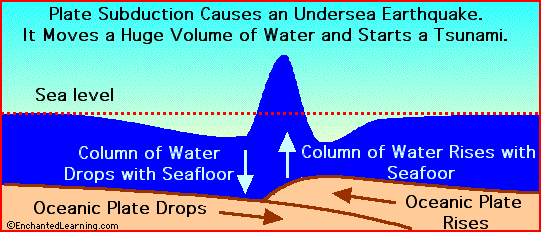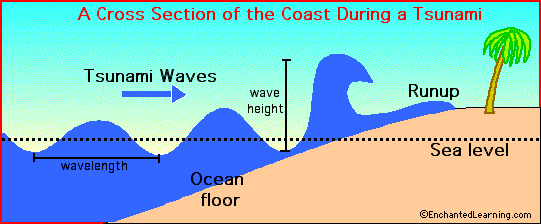

The most common causes of tsunamis are underwater earthquakes. To understand underwater earthquakes, you must first understand plate tectonics. the theory of plate tectonics suggests that the lithosphere, or top layer of the earth, is made up of a series of huge plates. These plates make up the continents and seafloor. They rest on an underlying viscous layer call the asthenosphere.

Formation of a Tsunami
When two plates come into contact at a region known as a plate boundary, a
heavier plate can slip under a lighter one. This is called subduction.
Underwater subduction often leaves enormous "handprints" in the form of deep
ocean trenches along the seafloor.
In some cases of subduction, part of the seafloor connect to the lighter plate
may "snap up" suddenly due to pressure from the sinking plate. This results in
an earthquake. The focus of the earthquake is the point within the Earth where
the rupture first occurs, rocks breaks and the first seismic waves are generate.
The epicenter is the point on the seafloor directly able the focus.
When this piece of the plate snaps up and sends tons of rock shooting upward
with tremendous force, the energy of that force is transferred to the water. The
energy pushes the water upward above normal sea level. This is the birth of a
tsunami.

|
Tsunamigenic Events |

Once the water has been pushing upward, gravity acts on it, forcing the energy out horizontally along the surface of the water. It's sort of the same ripple effect you get from throwing a pebble in the water, but in reverse: The energy is generate by a force moving out of rater than into the water. The energy then moves through the depths of the water and away from the initial disturbance.
The tremendous force
created by the seismic disturbance generates the tsunami's incredible speed. The
actual speed of the tsunami is calculated by measuring the water depth at a
point in time when the tsunami passes by. The speed is the square root of the
product of acceleration of gravity and the quantity of water depth or:
t = square root (g x d)
t = tsunami speed in meters per second
g = acceleration of gravity (32 feet/10 meters per second)
d = quantity of water depth
A tsunami's ability
to maintain speed is directly influenced by the depth of the water. A tsunami
moves faster in deeper water and slower in shallower water. So unlike a normal
wave, the driving energy of a tsunami moves through the water as opposed to on
top of it. As a result, as a tsunami moves through deep water a hundreds of
miles an hour, it is barely noticeable above the waterline. A tsunami is
typically no more than 3 feet (1 meter) high until it gets closer to shore.
Once a tsunami gets close to shore, it takes its more recognizable and deadly
form.

|
Tsunami
Types This
distinction is made based on the time it takes the tsunami to leave the
source disturbance and reach land. A distance tsunami travels more than
600 miles (1,000 km) from the source area before it reaches land.
Distant tsunamis are more likely to occur in the Pacific Ocean and are
capable of traveling across the entire ocean in less than one day. Since
distant tsunamis make such long trips with a relatively constant speed,
experts can predict their arrival with a fair degree of accuracy. This
makes it easy to warn and evacuate people that could be affected by the
wave. |
